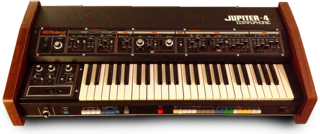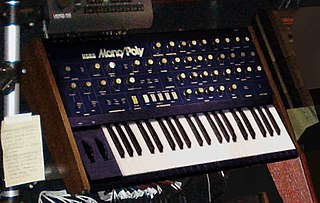
An analogsynthesizer is a synthesizer that uses analog circuits and analog signals to generate sound electronically.

Modular synthesizers are synthesizers composed of separate modules for different functions. The modules can be connected together by the user to create a patch. The outputs from the modules may include audio signals, analog control voltages, or digital signals for logic or timing conditions. Typical modules are voltage-controlled oscillators, voltage-controlled filters, voltage-controlled amplifiers and envelope generators.

CV/gate is an analog method of controlling synthesizers, drum machines, and similar equipment with external sequencers. The control voltage typically controls pitch and the gate signal controls note on-off.
The Yamaha AN1x is a DSP-based analog modeling synthesizer, produced by Yamaha Corporation from 1997 to 1998, and was marketed as an "analog physical modelling control synthesizer".

The Realistic Concertmate MG-1 is an analog synthesizer manufactured by Moog Music in 1981 and sold by Radio Shack from 1982 to 1983 under their "Realistic" brand name. It was produced without some standard Moog features, such as pitch and modulation wheels, as a cost-cutting measure aimed at achieving a lower price for the consumer market. The synthesizer also featured a pair of pass-through RCA jacks, which allowed users to mix radio or records into the final live synthesized sound output.

The Roland Jupiter-4 (JP-4) was an analog synthesizer manufactured by the Roland Corporation between 1978 and 1981. It was notable as the company's first self-contained polyphonic synthesizer, and for employing digital control of analog circuits, allowing for such features as programmable memory, voice assignment modes, an arpeggiator, polyphonic portamento and others.

MOTM is the name of the modular synthesizer system manufactured by Synthesis Technology. MOTM is an acronym for "Module of the Month".

The Moog model 2090 Micromoog is a monophonic analog synthesizer produced by Moog Music from 1975 to 1979.

The Moog Sonic Six is a duophonic analog synthesizer that was manufactured by Moog Music from 1972 to 1979. Because of its portable design and built-in speaker, the Sonic Six was widely used for lectures and educational purposes, often by Bob Moog himself.

The Korg Polysix(PS-6) is a six-voice programmable polyphonic analog synthesizer released by Korg in 1981.

The Doepfer A-100 is an analog modular synthesizer system introduced by German audio manufacturer Doepfer in 1995. Although there were only 10 module types at time of release, it currently has more than 120 modules plus several different enclosures and accessories.

The Yamaha CS30/CS30L is an analog keyboard synthesizer that was released in 1977. It is the top of the range in Yamaha's original line-up of monophonic synthesizers, others in the range being the CS5, CS10 and CS15. It features two voltage controlled oscillators (VCOs), two voltage controlled filters, two voltage controlled amplifiers (VCAs) and three envelope generators. It also sports a ring modulator and a voltage controlled low-frequency oscillator (LFO).

The Serge synthesizer is an analogue modular synthesizer system originally developed by Serge Tcherepnin, Rich Gold and Randy Cohen at CalArts in late 1972. The first 20 Serge systems were built in 1973 in Tcherepnin's home. Tcherepnin was a professor at CalArts at the time, and desired to create something like the exclusively expensive Buchla modular synthesizers "for the people that would be both inexpensive and powerful." After building prototypes, Tcherepnin went on to develop kits for students to affordably build their own modular synthesizer, production taking place unofficially on a second floor CalArts balcony. This led to Tcherepnin leaving CalArts in order to produce synths commercially, starting in 1974.

The Oberheim Xpander is an analog synthesizer launched by Oberheim in 1984 and discontinued in 1988. It is essentially a keyboardless, six-voice version of the Matrix-12. Utilizing Oberheim's Matrix Modulation technology, the Xpander combined analog audio generation with the flexibility of digital controls logic.

The Polivoks is a duophonic, analog synthesizer manufactured and marketed in the Soviet Union between 1982 and 1990. It is arguably the most popular and well-known Soviet synthesizer in the West, likely due to the uniqueness of both its appearance and sound.

The Korg Mono/Poly (MP-4) is a 44 key "mono-polyphonic" analog synthesizer manufactured by Korg from 1981 to 1984. This keyboard is the sister synthesizer to the Korg Polysix. It has four highly stable voltage-controlled oscillators (VCOs), a 4-pole, self-oscillating low pass filter (LPF), wide modulation capabilities and pseudo-polyphony (paraphony).
The Roland MKS-80 Super Jupiter is a rack mount sound module version of the Roland Jupiter-6 and the Roland Jupiter-8 synthesizers. It is an 8-voice polyphonic analog synthesizer that was manufactured by Roland between 1984 and 1987. It is the only one of the MKS series of synthesizers to have analogue voltage-controlled oscillators (VCOs) instead of analogue digitally-controlled oscillators (DCOs). The voice architecture is almost identical to the Jupiter-6 synthesizer. The service manual states that "The module board of MKS-80 features the following in addition to that of JP-6, its brother module. 1) HPF. 2) Low boost circuit in the 2nd VCA. 3) DC supply current boost circuit (IC50)."

The Steiner-Parker Synthacon is a monophonic analog synthesizer that was built between 1975 and 1979 by Steiner-Parker, a Salt Lake City-based synthesizer manufacturer. It was introduced as a competitor to other analog synthesizers, like the Minimoog and ARP Odyssey.

The AX60 is a polyphonic analogue keyboard synthesizer manufactured by Akai Professional in the mid-1980s. It was Akai's answer to the popular Roland Juno series synthesizers. The AX60 uses voltage-controlled analogue oscillators and filter circuitry based on the Curtis Electronics CEM 3394 integrated circuit.

The Roland System 700 was a professional monophonic modular synthesizer for electronic music manufactured by the Roland Corporation and released in 1976 and was followed by the Roland System-100M in 1978.




















